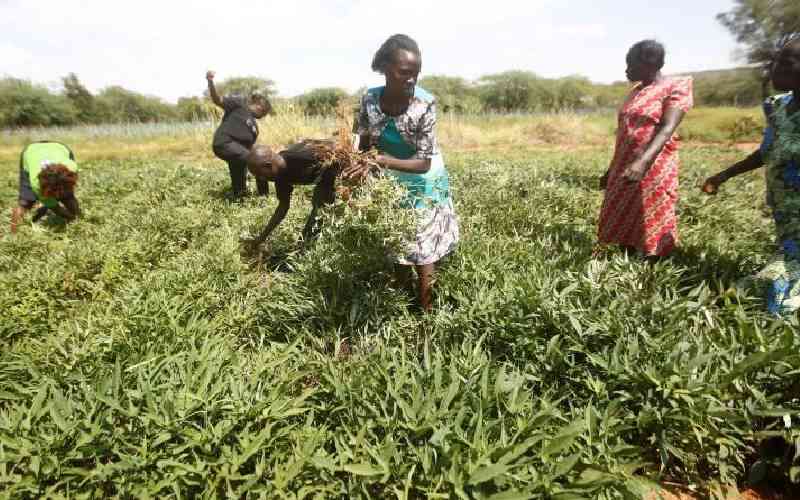
The East African Community stands to gain from encouraging the growth of regional soybean value chains. As things stand, soybeans are one of the world’s most important and traded oilseeds. However, there are a number of key constraints that need to be reformed in order to create an enabling environment.
For decades, the common bean has been the dominant and popular legume for smallholder farmers in East Africa, largely due to the ready markets and its popularisation as a rich and affordable source of vegetable oils and proteins. Recently, there has been growing demand for a new type of bean. National governments, together with development and research organisations, are pushing for more cultivation of the soybean due to its many advantages.
Soybeans are among the top global agricultural commodities, and are in greater demand on the international market than most common bean varieties. Indeed, the market for soybean in Africa is growing faster than any other staple crop for a number of reasons.
A wide array of products can be extracted from soybeans including soy milk, soy mince, soybean oil, dry-roasted soy nuts, as well as soy meal and cake which are highly sought after by animal feed manufacturers. The crop has a short growing season, and is simple and relatively affordable to grow.
These factors give soybeans the potential to improve food security and increase the livelihoods of millions of small-holder farmers.
In order to grow the industry and take advantage of the opportunities that exist, a number of improvements need to take place along the value chain. Central to these changes, agronomic practices must improve radically, and proper training should be provided to smallholder farmers.
A number of constraints have been identified. First, while there has been Government backing over recent years, there is scope for increased buy-in from the public sector in order to facilitate and expedite the formation of an effective regional soybean programme. Quality control is a huge hurdle to overcome as counterfeit soybean inputs have plagued the value chain across the region, whilst in some markets, seed contamination has affected yields.
Soy production in East Africa remains critically low, partly because regulations make it difficult to buy and sell across borders. A better harmonised policy environment in the region would encourage private sector investment in storage, processing and transportation infrastructure, and support higher and more predictable production and demand for soybeans.
Access to agricultural financing has also been an issue across the region, particularly in the current economic climate, but in the future, agro-financing will take on greater importance in the expansion of regional markets. President Akinwumi Adesina of the African Development Bank pointed out the opportunities that exist through agro-allied industrialisation, stating that Africa needs to diversify from raw material production to developing value chains. He notes, “the key is to use agriculture as a sector for wealth generation and not one to fight poverty.”
Until the region’s trade policies are improved and streamlined, policy blockages will remain a barrier to a viable regional soya industry. In any value chain, unpredictable trade policies, together with competing interests within the industry, will inevitably cause problems.
Regional trade integration must be the cornerstone of EAC member states’ trade policies, including the strengthening of public institutions and private sector organisations for local processing and export promotion. To remove barriers, value chain actors must come together to form strategic partnerships and advocate for policy changes, as well as the implementation of existing policies beneficial to the sector.
We have the knowledge and the capacity to succeed - and with predictable regulation and clear market signals, we can build an industry and improve livelihoods across the region.
Mr Tallam is the FoodTrade East & Southern Africa Market Systems Expert
Stay informed. Subscribe to our newsletter
 The Standard Group Plc is a
multi-media organization with investments in media platforms spanning newspaper
print operations, television, radio broadcasting, digital and online services. The
Standard Group is recognized as a leading multi-media house in Kenya with a key
influence in matters of national and international interest.
The Standard Group Plc is a
multi-media organization with investments in media platforms spanning newspaper
print operations, television, radio broadcasting, digital and online services. The
Standard Group is recognized as a leading multi-media house in Kenya with a key
influence in matters of national and international interest.
 The Standard Group Plc is a
multi-media organization with investments in media platforms spanning newspaper
print operations, television, radio broadcasting, digital and online services. The
Standard Group is recognized as a leading multi-media house in Kenya with a key
influence in matters of national and international interest.
The Standard Group Plc is a
multi-media organization with investments in media platforms spanning newspaper
print operations, television, radio broadcasting, digital and online services. The
Standard Group is recognized as a leading multi-media house in Kenya with a key
influence in matters of national and international interest.










